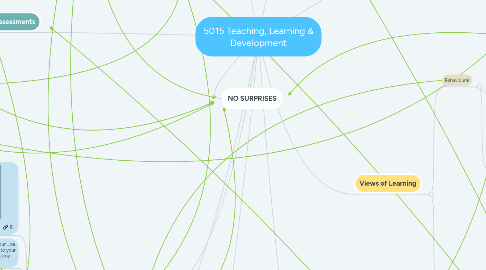
1. The 5 Whys Problem-solving Method
2. Planning
2.1. Graphic organizers
2.1.1. Graphic Organizers for Teachers Grades (K-12) - TeacherVision
2.1.1.1. Mind maps
2.1.1.2. Venn diagrams
2.1.1.3. Blooms Box
2.1.1.4. PMI - Positive, Minus, Interesting
2.2. Schwab's Four Commonplaces: Someone (the teacher) teaches something (the curriculum) to someone else (the student) somewhere (the classroom).
2.3. "Learners...feel engagement with purpose when they feel they have made a choice." (Watkins, Leading Learning, 29.)
2.4. Lesson plans
3. Positive learning environment
3.1. The Myth of Average: Todd Rose at TEDxSonomaCounty
3.2. "That problem is student misbehaviour....be forewarned: It is the major obstacle to your success and has the potential to destroy your career." - Charles (2002)
3.3. Dynamic classroom management
3.3.1. Teacher and students develop classroom expectations and consequences
3.3.2. Expectations posted in class
3.3.3. Parents are kept informed
3.3.4. CONSISTENCY, CONSISTENCY, CONSISTENCY
3.4. Communities of learners
3.5. Requires good planning - good teachers have a system
3.6. Inclusive & welcoming
3.7. "Students do well if they can. If they can't, we adults need to figure out why so we can help." - Dr. Ross Green
4. NO SURPRISES
5. Assessments
5.1. Assessment should focus on learning for improvement, not just for the score on a test. "Weighing the pig does not make it grow." - Ruth Sutton
5.1.1. Standardized testing
5.1.1.1. Criticisms
5.1.1.1.1. Stressful - for everyone
5.1.1.1.2. Teaching to the test
5.1.1.1.3. Doesn't match inquiry-based learning
5.1.1.1.4. Conditions at the time affect results
5.1.1.2. Criterion-based vs norm-based
5.1.1.3. Supports
5.1.1.3.1. Accountability for teachers and administrations
5.1.1.3.2. Ensures students across Ontario get roughly the same education
5.1.2. Diagnostic
5.1.2.1. Student profiles: observation, previous assessments, journals, OSRs, info from parents, admin and previous teachers
5.1.3. Formative
5.1.3.1. Self-assessment
5.1.3.2. Provides opportunities to improve
5.1.3.3. Affirmation of capability
5.1.4. Summative
5.2. Criterion-based not norm-based
6. Individual Differences
6.1. "School systems are not responsible for meeting every need of their students. But when the need directly affects learning, the school must meet the challenge." - Carnegie Council Task Force
6.1.1. Ensure students can physically and cognitively access the curriculum
6.1.1.1. Theory of multiple intelligences - Wikipedia
6.1.2. http://www.edu.gov.on.ca/eng/general/elemsec/speced/LearningforAll2013.pdf
6.1.3. IEPs
6.1.4. Tier 1: Core Program (Where all students need to go)
6.1.5. Tier 2: Supplemental Interventions (What some students need to get there)
6.1.6. Tier 3: Intensive Interventions (What this student needs to get there)
7. Social & Cultural Considerations
7.1. Every school is multi-cutlural now
7.2. Must consider their backgrounds and needs - relevant programming
7.2.1. Aboriginal students
7.2.2. Socio-economic status
7.2.2.1. The biggest factor in a child's ability to learn
7.2.2.2. Have realistic expectations
7.2.3. culturally responsive teaching
7.2.4. https://www.youtube.com/watch?v=D9Ihs241zeg&feature=youtu.be
8. Child & Adolescent Development
8.1. Genetics set development potential; environment determines potential realized
8.1.1. Zone of Proximal Development https://goo.gl/images/DdCe43
8.1.2. Scaffolding
8.1.3. Stress-performance connection
8.1.4. Bloom's taxonomy
8.1.4.1. Knowledge
8.1.4.2. Comprehension
8.1.4.3. Application
8.1.4.4. Analysis
8.1.4.5. Synthesis
8.1.4.6. Evaluation
8.1.5. Growth mindset
9. Making Instructional Decisions
9.1. Universal instructional design
9.2. Differentiated learning
9.3. https://www.youtube.com/watch?v=d8F1SnWaIfE&feature=youtu.be
9.4. Backward design
9.4.1. 1. What do I want my student to learn?
9.4.1.1. What are the enduring understandings?
9.4.2. 2. How will I determine if they've learned or not?
9.4.3. 3. What will I teach?
9.4.3.1. Curriculum expectations
9.4.4. 4. How will I teach it?
9.4.4.1. Authentic, meaningful tasks; inquiry-based approach
10. Views of Learning
10.1. Behavioural
10.1.1. Use a Learning Theory: Behaviorism
10.1.1.1. Incentives & punishments
10.1.1.1.1. Learn all about ClassDojo ♥
10.1.1.1.2. Classcraft - Engagement Management System for K-12 Educators
10.1.2. Reciprocal determinism: proposed by psychologist Albert Bandura. Three factors influence behaviour:
10.1.2.1. Environment
10.1.2.2. Individual
10.1.2.3. Behaviour itself
10.2. Rejection of direct learning; learning must have meaning to the student
10.2.1. Cognitive
10.2.1.1. Cognitive learning theorists
10.2.2. Constructivist (aka Social-Cultural): rejection of teacher-centred approach; support for a student-centred approach
10.2.2.1. "Learning is not the product of teaching. Learning is the product of the activity of learners." - John Holt
10.2.2.2. Use a Learning Theory: Constructivism
10.2.2.3. Scaffolding: assessing students' current knowledge and experience for the academic content

